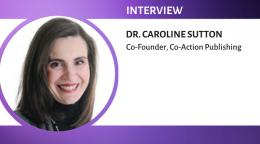Editorial Manager: Lending structure to the academic publishing ecosystem

Richard Wynne has been with Aries Systems Corporation since January 1999, and has played a major role in the development of Editorial Manager, the world’s leading online manuscript submission and peer review tracking system. Richard has also been involved in the development of ProduXion Manager, which serves the purpose of a content management system and is used by journals for post-acceptance manuscript tracking. In this interview, Richard talks about how tools like Editorial Manager benefit various segments of the publishing industry.
Editorial Manager is a very widely used manuscript submission and peer review system. It is also your flagship product. Could you tell us about how it has evolved over the years and what makes it one of the best workflow solution tools?
“Evolution” is exactly the right word! Too often publishers have an outdated view of software development as a one-time event followed by minimal maintenance. But in the last 15 years the nature of software delivery has changed dramatically. Even “boring” applications such as publisher workflow systems applications need to be constantly upgraded to respond to changing business models, new standards, new UI modalities, and shifts in the underlying technology environment.
For this reason Aries invests more than $6 million per year in new technology. We hold three user group meetings per year (Boston, London, and Tokyo—in partnership with Atlas Corporation) where we invite users to tell us about their workflow needs. For example, last year we heard from system administrators that managing email letters across multiple journals was a big pain point. In response to this, we’ve developed a global editing tool to help manage letters from multiple journals centrally.
In other words, we’ve evolved by listening carefully to customer needs and have systematically invested resources to respond to those needs.
For some time now, you’ve been working on tools that can help journals structure authors’ manuscripts after submission. In a 2009 interview, you talk about how journal submission systems like Editorial Manager can improve the process of creating structured manuscripts. In this context, can you talk about your newest offering EM Ingest and how it is relevant?
Finding a solution to for automatic manuscript structuring is the “Holy Grail” of scholarly workflow systems, and to be honest we’re still on the quest! We’re still exploring and analyzing tools that will reliably and automatically transform the author’s raw submission into clean XML. On the positive side, JATS (NLM DTD) has now been accepted by most journals as the de facto standard for manuscript structuring, and ORCID has emerged as the gold standard for author identification.
Given these market and technical dynamics, Aries recently launched the EM Ingest service. The idea behind EM Ingest is simple. Authorized third parties, such as professional editing companies, can add value to an author’s manuscript and then be authorized to directly submit the final manuscript on behalf of the author to any journal that uses Editorial Manager. This enables not only pre-submission content enrichment such as language editing and detailed subject-matter checks by the third party but also better structuring. The authors benefit from such an arrangement because they don’t have to re-key or identify the growing amount of metadata (e.g., FundRef) that journals increasingly require because of funder or institutional pressures. The diagram below explains the process.
How do you think new tools and services like EM Ingest will change the publishing ecosystem?
It’s a personal opinion, but in 5 years I expect that more than 30% of submissions to journals globally will be routed though submission partners rather than hand-entered by the authors directly into publisher submission systems. This will be much more convenient for authors, will allow up-front manuscript structuring, and will enable the capture of accurate metadata. Standards such as JATS and ORCID are already making this possible. We are also seeing the development of innovative manuscript authoring and collaboration tools, and it makes sense for these tools to transfer the manuscripts directly into the journal’s system for peer review since they already hold accurate and structured metadata.
Could you give our readers an overview of Aries? What does it do? How long has it been in the STM industry?
Aries was founded in 1986 by Lyndon Holmes, the CEO and President of Aries. The company has a long-term focus and commitment to scholarly publishing, including membership of industry associations such as CSE, SSP, STM, and ISMTE.
Aries is a Software-as-a-Service company that specializes in workflow systems for scholarly publishers. Aries systems are used by over 6,000 journals for manuscript submission and peer review resulting in millions of interactions with authors, reviewers, and editors each year. Our customers include large commercial publishers such as Springer, Wiley VCH, and Elsevier, but we also work with hundreds of scholarly societies including the American Psychological Association, the American Meteorological Society, and the Society for General Microbiology. Many of our customers are Open Access publishers such as PLOS, BMC, and Cogent.
What are the different Aries products? What does each of them do?
Our core product is Editorial Manager. It was first introduced in 2001 and is used by publishers for manuscript submission and peer review. A few years ago, we spotted the opportunity to extend our workflow solutions for journals with a new tool, ProduXion Manager, to help post acceptance manuscript tracking. ProduXion Manager eliminates the need for publishers to house and maintain expensive back-office content management systems. For example, Wolters Kluwer were able to replace their existing system (Documentum®) with ProduXion Manager for 300 journals.
Because Aries’ systems provide the back-bone for manuscript workflow, we are able to offer ancillary solutions to address a variety of needs such as plagiarism detection, automatic reference checking and formatting, and APC (Article Publication Charge) processing, typically in collaboration with our business partners.
Aries held its annual European User Group meeting not long ago. Our readers would be interested to know how a user group helps a technology company like Aries, who makes up user groups, and what happens at user group meetings?
They say that imitation is the highest form of flattery, so let me admit that I got the idea from HighWire—pioneers in scholarly publishing user group meetings. User groups serve two functions. Firstly they allow Aries to inform users about new developments and initiatives. Secondly, and more importantly, they allow Aries to carefully listen to customer needs. The most popular session is the “workshop” where attendees break-up into small groups and meet with Aries product management representatives to discuss use-cases, pain points, and desired solutions. You can spend millions on market research, or you can have user group meetings!
To wrap up, where do you see Aries and Editorial Manager three years from now? Please share any exciting developments in the offing.
Because of strong cultural forces in scholarly research, change will remain incremental. Aries plans to continue to invest more than $6million per year to build-out UI enhancements, tools for new workflow options such as open peer review, growing use of manuscript transfer between journals, improved journal office efficiency and accelerated adoption of standards. Aries is delighted that Editage is the first Submission Partner to adopt EM Ingest! Going forward, a growing number of organizations like Editage will adopt EM Ingest and major collaborations for automatic content validation in specialized fields. ORCID single-sign-on has already been activated by more than 500 Editorial Manager journals, but I expect this to grow rapidly because of the massive benefit to authors. APC processing will continue to morph into quasi subscription models, and the Editorial Manger APC API will enable such transitions thanks to the integration of tools such as RightsLink for Open Access from the Copyright Clearance Center (CCC). The underlying theme is that the emergence of standards in scholarly publishing is finally enabling efficient collaboration.
Full disclosure: Editage has collaborated with Aries to directly transfer manuscripts on behalf of Editage authors to participating journal Editorial Manager (EM) submission sites and to simplify the manuscript submission workflow for both authors and journals. However, this interview has been conducted independently by Editage Insights and poses no commercial conflict of interest.
Related reading:
How journals make assertions: An insight into the publishing industry
Published on: Apr 19, 2015
Comments
You're looking to give wings to your academic career and publication journey. We like that!
Why don't we give you complete access! Create a free account and get unlimited access to all resources & a vibrant researcher community.







